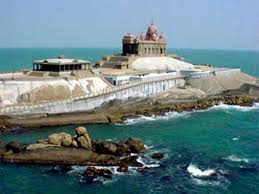 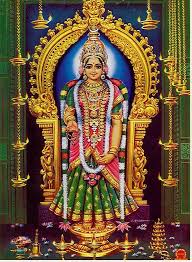 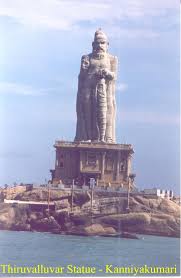 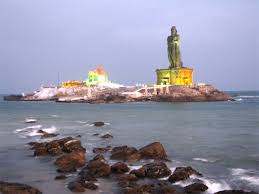 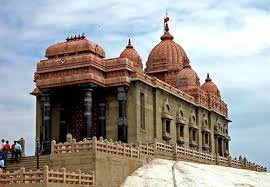 |
Kanyakumari District (Tamil: கன்னியாகுமரி மாவட்டம், Malayalam: കന്യാകുമാരി ജില്ല) (also spelled Kanniyakumari or Kanniakumari District) is a district of Tamil Nadu state, India; it is the southernmost land area of mainland India.
Kanyakumari District is the smallest of the 32 districts of Tamil Nadu state. The district takes its name from the tourist town of Kanyakumari, which is at the tip of the Indian Peninsula and faces the Indian Ocean. The administrative capital of the district is Nagercoil, which is 20 km from Kanyakumari town.The district has the best litrecy rate in the state and is considered the best educated district in the Indian state of Tamil Nadu by the HRD Ministry.It is the third most developed district in the state and is leading in most of the parametersThe District has large population of NRI's in the Gulf. It was ranked third in a comprehensive Economic Environment index ranking of districts in Tamil Nadu not including Chennai prepared by Institute for Financial Management and Research in August 2009.[1]
The district is known as "The District of Ponds" or "The Lands End" It has two protected areas:
1. Kanyakumari Wildlife Sanctuary
2. Suchindram Theroor Birds Sanctuary
location

Kanyakumari District is located at the southern tip of peninsular India and bordered by Thiruvananthapuram district of Kerala state to the west and Tirunelveli District of Tamil Nadu to the north and east. It is also sometimes referred to as "Land's End".[2]
The district lies between 77° 15' and 77° 36' of the eastern longitudes and 8° 03' and 8° 35' of the northern Latitudes. The south-eastern boundary (coastal) is the Gulf of Mannar (Bay of Bengal), while on the South and the South West, the boundaries are the Indian Ocean and the Arabian Sea.
Administrative divisions
- No. of Taluks - 4
- Blocks - 9
- Municipalities - 4 (Nagercoil, Padmanabhapuram, Colachel, Kuzhithurai)
- Village Panchayats - 99
- Special category village panchayats - 56.
Recorded History

Kanyakumari District takes its name from the town of Kanyakumari, at the southern tip of India. (In many Indian languages Kumari means virgin girl). Thus, Kanyakumari District is also sometimes called Kumari District. Kanyakumari town is named after the goddess Kanyakumari Amman, a popular deity of the area. Legend has it that the goddess Parvati in one of her incarnations as Devi Kanniya did penance on one of the rocks of this 'land's end' to obtain the hand of Lord Shiva.
The town of Kanyakumari is geographically a cape, and it was known earlier as Cape Comorin. Since ancient times, Kanyakumari District has consisted of two geographical areas, known locally as Nanjilnadu and Idainadu. The etymologists interpret the word Nanjilnadu as the country ("nadu") where there were (and still has) several agriculture plantations and fields. Nanjilnadu is mentioned in old Tamil literature as a rich agrarian area, where the town of Kottar, (today, a locality in Nagercoil) as a major commercial centre. Ancient temples and inscriptions reveal a major Jain influence in ancient times. The district is home to many practitioners of various branches of ancient India's health tradition, including siddha, ayurvedha, and varma kalai.
Nanjilnadu, which was formed by the present Agasteeswaram and Thovalai TaluksPandyas and the Cheras until the beginning of the thirteenth century. Idainadu, including Kalkulam and Vilavancode Taluks, was under the rule of Cheras. When the power of Cheras declined due to the rise of Hoysalas and western Chalukyas, the VenadTravancore) chieftains (one of the only two part of full descendants of the Cheras - the other being the Mushikas) took advantage of the situation and gradually established their hold on many areas of Nanjilnadu. The annexation commenced by Veera Kerala Varma was to a large extent continued by his successors and completed by 1100 A.D. (administrative sub-divisions) of the district, was alternately under the rule of the (
For about four centuries, Venad was ruled by powerful kings who were consistently making incursions into the Pandyan territories. As a result the Vijayanagar kings proceeded against Venad. In 1609 Kanyakumari fell into the hands of Viswanatha Nayak of Madurai, while the remaining parts of Nanjilnadu was under Venad. Later Venad was expanded towards the Northern Kerala, and came to be known as Thiruvithamkoor or Travancore. Padmanabhapuram near Nagarcoil was the capital of Travancore.
In 1729, Anizham Thirunal, the Travancore king expanded his kingdom dome further, after putting down the insurgency of the Ettuveettil Pillamar. He defeated the forces of the Dutch East India Company under Eustachius De Lannoy in 1741 at the Battle of Colachel. In the later part of the 18th century, Chanda Sahib, a rebel commandant related to the Nawab of Arcot attacked Nagercoil and other areas. Travancore had to contend with such attacks and monetary demands from the Carnatic Nawabs or from their rebellious governors until the English fully supported the state of Travancore.[citation needed] In spite of the troubles encountered in the southern border of Venad, Marthanda Varma expanded the kingdom northwards to Aluva and expanded the kingdom of Travancore. As a result, the present day Kanyakumari District came to be known as Southern Travancore. In 1745, the capital was shifted from Padmanabhapuram (in present day Kanyakumari District) to Thiruvananthapuram.
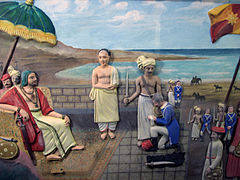
The rule of the Travancore royals finally ceased in 1947 when Travancore had to join the independent Indian Union. In 1949, Kanyakumari district became part of the newly constituted Travancore-Cochin state. The majority of the people of South Travancore Taluks (Kanyakumari District) were Tamil-speaking and a popular agitation for merging the Tamil majority areas of South Travancore to Madras State (now Tamil Nadu) was started during this period. The State Reorganisation Commission of India also recommended this. Accordingly, the Indian States Reorganisation Act of 1956 was passed and Kanyakumari District was formed on 1 November 1956 with the four Taluks, Viz., Agasteeswarem, Thovalai, Kalkulam and Vilavancode from Travancore, merged with Tamil Nadu. Thiru. R. Thirumalai, I.A.S., assumed charge as the first District Collector of Kanyakumari.[citation needed]
Though generally a peaceful place, violence flared up between Christians and Hindus in 1982 at the coastal village of Mandaicadu. In the subsequent violence and police shoot-outs in several parts of the coastal areas of the district and in Nagercoil, several people were killed.
On 26 December 2004, the Indian Ocean Tsunami that struck several countries of South Asia, South-East and Africa caused havoc in the coastal areas of the district, with the western coast of the district severely affected. Casualties were close to 900 and several hundreds were missing or injured. Social organizations from several countries and the Government have since been working on rehabilitating the affected people and property.
The land and geographical features
Kanyakumari is the smallest district in Tamil Nadu, with a land spread of 1,684 km² and has varied ecosystems - forests, wetlands, freshwater resources and marine as similar to Kerala.
The district, once called "The Granary of Travancore" is fertile, with hundreds of water bodies and a canal irrigation system. Rubber and spice plantations are found on the hilly terrain, while paddy fields, plantain and coconut plantations are found on the plains.
The district is generally hilly, with plains found near the coast. The land from the sea-coast gradually rises from sea-level to the Western-Ghats hills in the deep interior of the district. The District has 62 km of coast on the western side (Arabian Sea coast) and 6 km of coast on the eastern side (Gulf of Mannar/Bay of Bengal coast).
There are three important riverine ecosystems, which converge with the Arabian Sea. They are :
- Thengapattinam estuary, formed by the confluence of river Tampirabarani in between Thengapattinam and Eraiummanthurai.
- Valliyar estuary formed by the river Valloiyar near Kadiapattinam.
- Manakudy estuary formed by the confluence of river pazhaiyarin between East and West Manakudy villages.
Two minor estuaries—Pambar estuary near Colachel and Pantri estuary near Rajakkamangalam—are also located in the district. These are formed by excess water in the drainage canal during monsoon and the water drained from the irrigated fields.
Soil types
- Laterite soil is found at Thiruvattar, Killiyoor, Munchirai, Rajakamanagalam, Thuckalay blocks.
- Red and alluvial soil are found at Agastheeswaram and Thovalai blocks.
The soil pH is between 4.5 to 8.0. The minerals in soil - nitrogen: low to medium, phosphorus: medium, potassium: high
48.9% of land in the district is under cultivation and 30.5% is covered by forests.
Demography
As of 2001, the district had a population of 1,676,034 and 65.2% of the district is urbanised. It has a high population density of 995.7 persons per km2 and is one of the highest literate regions with a total literacy rate of 87.6. The district also has a high female sex ratio of 1014 females born to every 1000 males.[3]
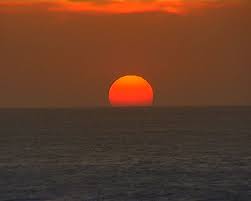
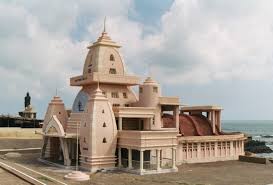







0 comments:
Post a Comment